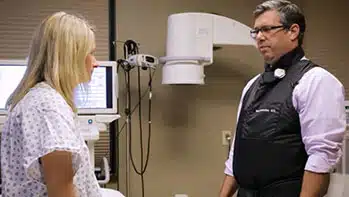Radiofrequency Rhizotomy
Radiofrequency (RF) rhizotomy, or neurotomy, is a therapeutic procedure designed to decrease or eliminate nerve pain symptoms that have not responded to more conservative pain treatments. The procedure uses highly localized heat generated with radiofrequency to destroy the nerves causing the pain. Destroying these nerves prevents pain signals from being transmitted from the spine to the brain. A successful procedure reduces pain without reducing nerve function.
Preliminary Testing
Before an RF rhizotomy exam can be scheduled, it is important for our radiologists to identify where the pain originates. Exams required to determine these areas might include MRI of the spine, nerve block injections with local anesthetic (numbing medication) and steroids (anti-inflammatory medication), and possibly discography.
What to Expect
- We’ll contact you prior to your appointment to review current medications, your medical history, and potential risks. We’ll also answer any questions you have about the procedure.
- Be sure to tell us if you are pregnant, nursing, or if there is a chance you may be pregnant.
- Contact your doctor before you stop taking any medication.
- On the day of your exam, please arrive 15 minutes early to check in.
- The use of sedation during your procedure is at the radiologist’s discretion. If sedation is prescribed, you’ll receive detailed instructions so you know what to expect.
- If you will be sedated, you will need someone to drive you home and stay with you after the procedure due to the effects of the medications.
- Although complications are rare, we will review possible side effects and risks with you prior to your exam so you can ask questions and decide if this exam is right for you.
- When you arrive, you will be led to a changing room and given a pair of scrubs to wear for your exam. You will be given a locker to store your clothes, and anything else you may have with you during your exam.
- It is important that you remain awake during the procedure so you can provide feedback to the radiologist.
- Using X-ray guidance, our radiologist will insert a thin needle and inject contrast solution. The contrast solution is designed to highlight your anatomy to help ensure precise targeting of the nerve thought to be causing your pain.
- To verify the needle position, the nerve may be stimulated using low-voltage electricity. The stimulation will cause the affected muscles to rhythmically contract.
- A radiologist typically performs the procedure using a thin needle electrode placed adjacent to the degenerative facet joint.
- The radiologist will use numbing medication (anesthetic) to desensitize the nerve.
- Then, the radiologist will apply heat to the nerve via the electrode. This heat is designed to create a lesion, causing the nerve to become cauterized or burnt, which in turn breaks the communication link to the brain.
- This procedure can be repeated at other levels including the levels above and below where the pain is originating.
- Throughout the procedure, a radiologist and nurse will closely monitor your condition and comfort level.
- When your procedure is complete, you’ll be escorted back to the changing room so you can change out of the scrubs and back into your clothing.
- If you are sedated, a nurse will review some guidelines that you will be asked to follow post-procedure, such as driving, drinking alcoholic beverages, etc.
- You may experience numbness and/or relief from symptoms after the procedure due to the anesthetic.
- Once the local anesthetic effects have worn off, your usual symptoms may return and may be more severe for up to seven days after the procedure.
- Improvement occurs typically about two to three weeks after the procedure. However, it may take up to four weeks before symptoms improve and the beneficial effects of the rhizotomy are realized. Every patient is different and your outcome may vary.
- You may be asked to keep a record of symptoms following the procedure and report to the referring provider at your follow-up appointment.
